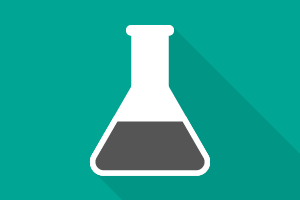Classroom Resources: Quantitative Chemistry
Filter by:
26 – 46 of 46 Classroom Resources
-

Gas Laws, Sublimation, Ideal Gas, Volume, Temperature, Pressure, Density, Phase Changes, Interdisciplinary, Density, Physical Change, Mole Concept, Dimensional Analysis, Measurements | High School
Demonstration: Ideal Gas Law using Carbon Dioxide Mark as Favorite (15 Favorites)
In this demonstration, students observe dry ice sublime while the CO2 gas fills a balloon. They then calculate the moles and volume of CO2 produced.
-

Limiting Reactant, Stoichiometry, Balancing Equations, Mole Concept, Dimensional Analysis, Molar Mass | High School
Activity: Sweet Stoichiometry Reactions Mark as Favorite (63 Favorites)
In this activity, students will use candy to investigate stoichiometry and mole-gram relationships in chemical equations, but could also be used to introduce the concept of limiting reactants.
-

Stoichiometry, Dimensional Analysis, Mole Concept | High School
Lesson Plan: How to do Stoichiometry Problems Mark as Favorite (56 Favorites)
In this lesson, students learn templates for performing stoichiometry problems. They then put the methods to the test with a practice worksheet.
-

Stoichiometry, Dimensional Analysis, Mole Concept, Gas Laws, Ideal Gas, Molarity, Concentration, Electrolysis, Electrons | High School
Lesson Plan: Stoichiometry Set-up Method Mark as Favorite (65 Favorites)
In this lesson, students will learn how to follow a process of visual cues in combination with a step-by-step problem solving method for different types of stoichiometric problems. This method can be particularly beneficial for students who struggle with completing multi-step calculations.
-

Heat of Neutralization, Acid Base Reactions, Exothermic & Endothermic, Temperature, Specific Heat, Calorimetry, Bond Energy, Net Ionic Equation, Molarity, Dimensional Analysis, Measurements, Mole Concept | High School
Lab: Heat of Neutralization Mark as Favorite (6 Favorites)
In this lab, students carry out an acid-base reaction to calculate the heat of neutralization based on experimental data. This lab will reinforce the concepts of exothermic and endothermic processes, system and surroundings, and heat of reaction (specifically, neutralization).
-

Solute & Solvent, Molarity, Tyndall Effect, Concentration, Stoichiometry, Dimensional Analysis, Mole Concept | High School
Activity: Solubility & Solutions Mark as Favorite (21 Favorites)
In this inquiry activity, students investigate types of solutions, identifying the solute and solvent, and classifying each solution. They them solve stoichiometry problems involving solutions of different concentrations.
-

Balancing Equations, Limiting Reactant, Stoichiometry, Dimensional Analysis, Mole Concept, Measurements | High School
Activity: S'more Stoichiometry Mark as Favorite (62 Favorites)
In this activity, students determine the number of graham crackers and chocolate pieces required to complete a “reaction” with a given quantity of marshmallows (the limiting reactant). They then use the same thought process with a problem involving a real chemical reaction.
-

Chemical Change, Limiting Reactant, Classification of Reactions, Percent Yield, Stoichiometry, Concentration, Molarity, Mole Concept, Dimensional Analysis | High School
Demonstration: First Day Review Mark as Favorite (20 Favorites)
In this demonstration, students see evidence of a chemical reaction.
-

Molecular Formula, Stoichiometry, Law of Definite Proportions, Dimensional Analysis, Mole Concept, Classification of Reactions | High School
Lab: Finding the Formula of Magnesium Oxide Mark as Favorite (23 Favorites)
In this lab, students will recognize that oxygen has mass and that heating can involve and increase in mass as an element reacts to become an oxide
-

Limiting Reactant, Concentration, Net Ionic Equation, Stoichiometry, Balancing Equations, Precipitate, Mole Concept, Dimensional Analysis | High School
Lab: Finding CO2 Mass in your Breath Mark as Favorite (37 Favorites)
In this lab, students will measure how much carbon dioxide they exhale by reacting their exhaled breath with limewater (calcium hydroxide solution). Students will practice writing balanced equations and completing mass-to-mass stoichiometric calculations.
-

Classification of Reactions, Oxidation, Reduction, Percent Yield, Stoichiometry, Chemical Change, Redox Reaction, Activity Series, Error Analysis, Dimensional Analysis, Mole Concept, Measurements | High School
Lab: Extracting Copper From Ore Mark as Favorite (16 Favorites)
In this lab, students extract copper from copper carbonate using two different methods, and then determine which industrial method is most effective.
-

Mole Concept | High School
Activity: Popcorn Counting Unit Mark as Favorite (55 Favorites)
In this activity, students develop a new method of counting objects, called the PCU, and compare this method to the concept of the mole.
-

Percent Composition, Percent Composition, Mole Concept, Dimensional Analysis | High School
Lab: Percent Composition of Bubble Gum Mark as Favorite (62 Favorites)
In this lab, students will be introduced to the concept of percent composition. Students will determine the amount of sweetener in various brands of gum by determining the mass difference of the gum before and after it is chewed.
-

Mole Concept, Significant Figures, Dimensional Analysis, Measurements, Scientific Notation, Molar Mass, Molecular Formula | High School
Activity: Can You Color A Mole? Mark as Favorite (91 Favorites)
In this activity, students determine how many moles of paraffin are used when they color a piece of paper as well as how many molecules and moles of wax are in one crayon.
-

Mole Concept, Measurements, Dimensional Analysis, Molar Mass | High School
Lab: Calculating Moles Mark as Favorite (69 Favorites)
In this lab, students will have the opportunity to practice conducting the chemist’s way of counting atoms and molecules by using the mole. They will determine the mass of various common elements and compounds and convert this data into values of moles, atoms and molecules. This will allow students to realize the connection between commonly used laboratory chemicals and the quantitative data and calculations that are such a fundamental part of chemistry.
-

Mole Concept, Dimensional Analysis, Measurements | High School
Activity: Bring Me A Mole Mark as Favorite (77 Favorites)
In this lab, students take an abstract concept, the mole, and turn it into a real measurable concept.
-

Limiting Reactant, Acid Base Reactions, Stoichiometry, Indicators, pH, Dimensional Analysis, Mole Concept, Measurements, Concentration, Molarity | High School
Lab: Acid/Base Stoichiometry Mark as Favorite (12 Favorites)
In this lab, students experience a limiting reactant and can physically see the difference in amounts of product generated. They also see which reactant is in excess.
-

Chemical Change, Gas Laws, Stoichiometry, Balancing Equations, Volume, Dimensional Analysis, Mole Concept | High School
Project: Air Bag Stoichiometry Mark as Favorite (123 Favorites)
In this lab, students make real-world connections of stoichiometry with the design of car air bags.
-

Mole Concept, Dimensional Analysis, Density | High School
Lab: Moles of Food Mark as Favorite (61 Favorites)
In this lab, students will analyze the nutrition label of a variety of foods to find the amount of specific elements in each serving. Students are asked to evaluate and compare the data in a series of questions, in order to convert the values to moles. This lab gives students the opportunity to see the connection between the chemistry mole concept and everyday foods.
-

Molarity, Concentration, Mixtures, Solute & Solvent, Dimensional Analysis, Mole Concept, Measurements | High School
Lab: Molarity of a Solution Mark as Favorite (42 Favorites)
In this lab, students calculate concentrations of and perform dilutions of Kool-Aid and juice solutions.
-

Mole Concept, Measurements, Dimensional Analysis | High School
Lesson Plan: Molar Marks Mark as Favorite (11 Favorites)
In this lesson, students will better understand the mole concept by using chalk to write their name on a sidewalk and finding out the composition of chalk through research.